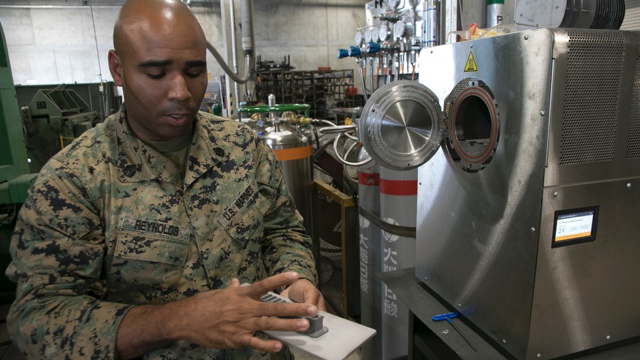

Markforged can happily claim to be a pioneer on a number of fronts in the additive manufacturing (AM) industry: 3D printing reinforcement fibers, low-cost metal 3D printing, unique quality control systems, software and more. While there are surely other new technologies on the horizon for the Boston-based startup, the most exciting offering from the company at the moment may be its metal 3D printing system, Metal X.
Demonstrating the capabilities of the Metal X, the U.S. military recently showed off its new Metal X system in a story for Stars and Stripes. In December, III Marine Expeditionary Force (III MEF) began running a Metal X system at its 3rd Maintenance Battalion shop at Camp Kinser one of the U.S.’s highly controversial military bases on the island of Okinawa.
The shop is staffed by 12 marines who repair parts for U.S. weapon systems and vehicles for all III MEF units, which occupy numerous bases across the small, Japanese island, as well as several bases on the larger island of Honshu and additional locations in South Korea and Hawaii. Typically, the crew has had to rely on CNC machines to make parts. As our readers know, this process can be costly, time consuming, and wasteful of material.
While the shop has had plastic 3D printers for the past four or five years, they have typically been reserved for prototyping. The Metal X system will make it possible for the military to 3D print metal end parts on demand. So far, these parts have included gauges for .50-caliber machine guns, sockets for wrenches and a piece to test weapon optics at the armory.
The Metal X extrudes metal powders bound together in a polymer matrix in a method similar to the traditional fused deposition modeling associated with desktop 3D printing. These “green” parts are then placed into a debinding station in which liquid argon washes away the plastic binder. The now “brown” parts are then placed into a furnace which sinters the metal parts for up to 27 hours and up to 1482°C, resulting in solid metal parts.

“Whereas with our new metal 3D printer, that opens up a whole new world for us,” shop foreman Staff Sgt. Quincy Reynolds said. “This piece of equipment is able to save time with the multiple prints and then you’re able to have a completed [piece] … that does not need any machining.
“Whereas a marine might spend eight to 12 hours machining a single component, the metal 3D printer can produce multiple parts at once. Once the initial layers are printed successfully, the solider can move on to other activities. In turn, one user can work on four projects at a time. Because the furnace the staff is using only holds about half the capacity that the Metal X can print, the shop will be upgrading to a larger furnace.
“We’re asking units, ‘Hey, just give us a problem. Let us figure out the solution for you,’” Reynolds said. “Right now, the sky is the limit honestly with this printer. If you can think of it, we can literally do it.”
From the description provided in Stars and Stirpes, the Metal X system is delivering on an endeavor that the U.S. military has long been pursuing: the ability to 3D print metal components on demand. The long-term goal for the military is to be able to make parts as close to a warzone as possible, potentially within portable fablabs.
Because the U.S. spends more on its military than the next seven countries combined, it has the expenses to research these cutting-edge initiatives and more. As the largest military force in the world (coincidentally also the largest polluter), the U.S. is under a seemingly constant need to develop its capability versus others that might challenge its hegemony. It has garrisoned the planet with over 1,000 military bases located in 80 countries, representing 95 percent of the globe’s total military installations (for comparison France, the U.K. and Russia have about 10-20 foreign outposts each and China has one).
As a result, the U.S. military is exploring a wide range of experimental 3D printing applications. Others include 3D printing meals for soldiers, 3D-printed grenade launchers, 3D-printed ship hulls, skin 3D printers for rapidly healing wounds.
Join the discussion of this and other 3D printing topics at 3DPrintBoard.com.
If you're looking to get architectural 3D animation in the USA, our service provides an exceptional way to bring your architectural concepts to life through dynamic, immersive visuals. Through our platform, you can easily request high-quality 3D animations that showcase your designs in motion, offering a detailed view of your project from multiple angles and perspectives. Whether it's for a real estate development, a commercial building, or an urban planning project, our expert team ensures that every detail is captured in a visually compelling animation.
Through our website, you can seamlessly get architectural 3D animation tailored to your project’s specific needs. With our help, you can offer potential clients or investors an engaging experience that goes beyond static images. By integrating CGI animations with real-world settings, lighting, and textures, our team creates a lifelike experience that allows your audience to interact with your project as though it were already built. This service is perfect for presenting complex designs in a clear, visually attractive way that stands out in the competitive architectural market.




